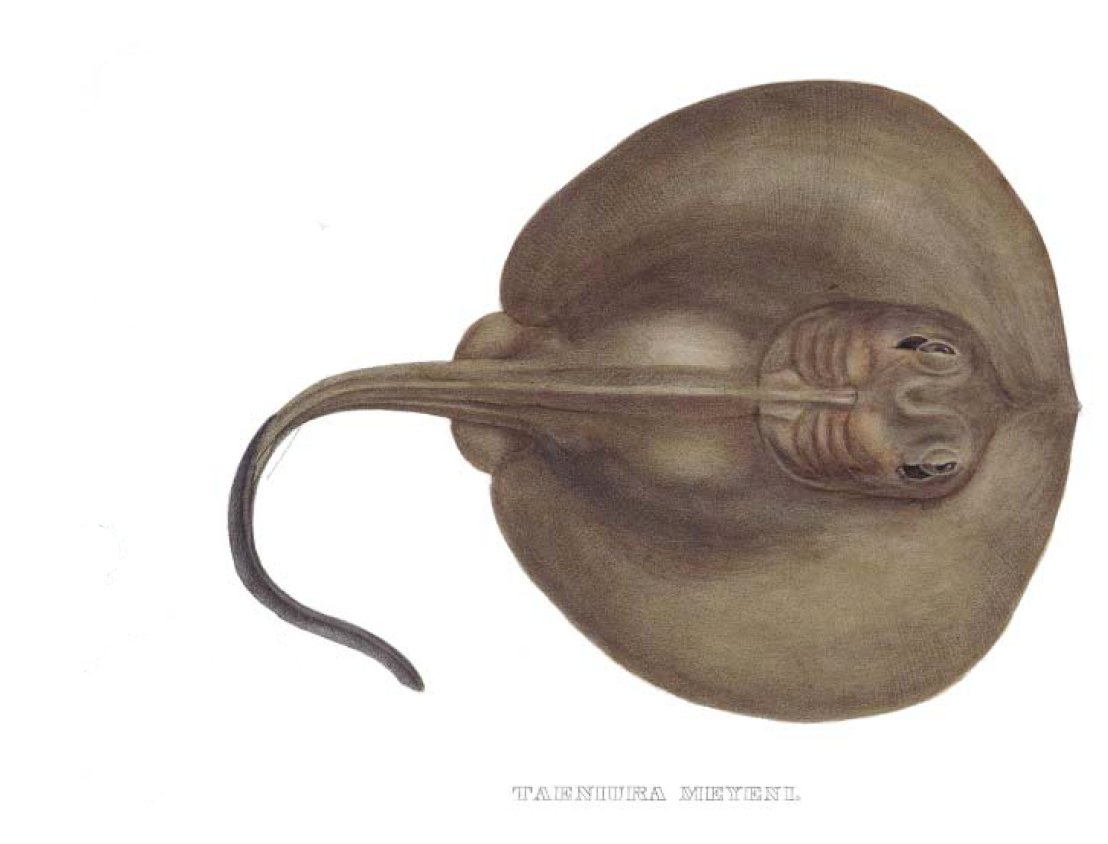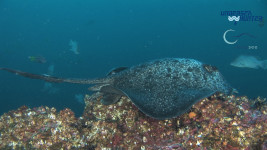Taeniurops meyeni
(Müller & Henle, 1841)
Blotched fantail ray
Classification: Elasmobranchii Myliobatiformes Dasyatidae
Reference of the original description
Systematische Beschreibung der Plagiostomen. Berlin, Veit, pp. 1–200
Systematische Beschreibung der Plagiostomen. Berlin, Veit, pp. 1–200
Image of the original description

Taeniurops meyeni (Müller & Henle, 1841)

Taeniurops meyeni (Müller & Henle, 1841)
Synonyms / new combinations and misspellings
Dasyatis melanospila, Taeniura melanospila, Taeniura melanospiles, Taeniura melanospilos, Taeniura meyeni, Taeniura mortoni
Dasyatis melanospila, Taeniura melanospila, Taeniura melanospiles, Taeniura melanospilos, Taeniura meyeni, Taeniura mortoni
Types
Taeniurops meyeni
Taeniura melanospilos
Holotype: RMNH: 7453
Taeniura meyeni
Syntype: MNHN: 2428; ZMB: 4660
Taeniura mortoni
Holotype: AMS: lost;
Taeniurops meyeni
Taeniura melanospilos
Holotype: RMNH: 7453
Taeniura meyeni
Syntype: MNHN: 2428; ZMB: 4660
Taeniura mortoni
Holotype: AMS: lost;
Description :
Citation: Taeniurops meyeni (Müller & Henle, 1841): In: Database of modern sharks, rays and chimaeras, www.shark-references.com, World Wide Web electronic publication, Version 12/2025
Please send your images of "Taeniurops meyeni" to info@shark-references.com

Taeniurops meyeni (Müller & Henle, 1841), ERB 1213, female, 30, 6 cm DW, 53, 6 cm TL, Kenya © Frederik H. Mollen (Elasmobranch Research Belgium)

Taeniurops meyeni (Müller & Henle, 1841), ERB 1213, female, 30, 6 cm DW, 53, 6 cm TL, Kenya © Frederik H. Mollen (Elasmobranch Research Belgium)
Common names
 Raya manchada,
Raya manchada,  Sartén marmoleado,
Sartén marmoleado,  Pastenague à taches noires,
Pastenague à taches noires,  Pastenague éventail,
Pastenague éventail,  Raie brisant,
Raie brisant,  Raie noire,
Raie noire,  Raie à tache noire,
Raie à tache noire,  Black spotted ray,
Black spotted ray,  Black-blotched stingray,
Black-blotched stingray,  Black-spotted stingray,
Black-spotted stingray,  Blotched fantail ray,
Blotched fantail ray,  Fantail ray,
Fantail ray,  Fantail stingray,
Fantail stingray,  Giant reef gray,
Giant reef gray,  Giant reef ray,
Giant reef ray,  Round ribbontail ray,
Round ribbontail ray,  Speckled stingray,
Speckled stingray,  Ratão cauda redonda
Ratão cauda redonda
 Raya manchada,
Raya manchada,  Sartén marmoleado,
Sartén marmoleado,  Pastenague à taches noires,
Pastenague à taches noires,  Pastenague éventail,
Pastenague éventail,  Raie brisant,
Raie brisant,  Raie noire,
Raie noire,  Raie à tache noire,
Raie à tache noire,  Black spotted ray,
Black spotted ray,  Black-blotched stingray,
Black-blotched stingray,  Black-spotted stingray,
Black-spotted stingray,  Blotched fantail ray,
Blotched fantail ray,  Fantail ray,
Fantail ray,  Fantail stingray,
Fantail stingray,  Giant reef gray,
Giant reef gray,  Giant reef ray,
Giant reef ray,  Round ribbontail ray,
Round ribbontail ray,  Speckled stingray,
Speckled stingray,  Ratão cauda redonda
Ratão cauda redonda
Short Description
A large stingray with a circular disc, no thorns, a black and white mottled upper surface, and a deep and prominent ventral skin fold that extends to the tail tip [1388].
A large stingray with a circular disc, no thorns, a black and white mottled upper surface, and a deep and prominent ventral skin fold that extends to the tail tip [1388].
Distribution
Indo-West Pacific: Red Sea and East Africa to southern Japan, Micronesia, tropical Australia and Lord Howe Island. Eastern Pacific: known only from oceanic islands (Cocos and the Galapagos) but because of sheer number, individuals may colonize the Central America mainland [16090]. More widely known as Taeniura melanospila Bleeker 1853, a junior synonym based on the description of a juvenile specimen. Source: www.gbif.org
Indo-West Pacific: Red Sea and East Africa to southern Japan, Micronesia, tropical Australia and Lord Howe Island. Eastern Pacific: known only from oceanic islands (Cocos and the Galapagos) but because of sheer number, individuals may colonize the Central America mainland [16090]. More widely known as Taeniura melanospila Bleeker 1853, a junior synonym based on the description of a juvenile specimen. Source: www.gbif.org
Human uses
fisheries: commercial; gamefish: yes
fisheries: commercial; gamefish: yes
Biology
Exhibit ovoviparity (aplacental viviparity), with embryos feeding initially on yolk, then receiving additional nourishment from the mother by indirect absorption of uterine fluid enriched with mucus, fat or protein through specialised structures [733]. Distinct pairing with embrace [17086]. With up to 7 in a litter [1388] [1658]. Inhabits sandy areas in coral reefs [17641]. A carnivore [17641].
Exhibit ovoviparity (aplacental viviparity), with embryos feeding initially on yolk, then receiving additional nourishment from the mother by indirect absorption of uterine fluid enriched with mucus, fat or protein through specialised structures [733]. Distinct pairing with embrace [17086]. With up to 7 in a litter [1388] [1658]. Inhabits sandy areas in coral reefs [17641]. A carnivore [17641].
Remarks
shark-references Species-ID=10240;
shark-references Species-ID=10240;
Parasites (arranged by Jürgen Pollerspöck)
Monogenea
Cestoda
Nematoda
Copepoda
Isopoda
Hirudinea
Monogenea
- Dendromonocotyle pipinna Chisholm & Whittington, 2004 [9445] [16099] [11256] [21215] [16098]
- Heterocotyle taeniuropi Cao, Ding, Zhang & Liu, 2010 [21215]
- Neoentobdella garneri Whittington & Kearn, 2009 [8814]
- Neoentobdella taiwanensis Whittington & Kearn, 2009 [8814] [16098]
Cestoda
- Pterobothrium minimum (Linstow, 1904) [16283] [16112]
- Tetrarhynchobothrium unionifactor (Shipley & Hornell, 1904) [16112]
Nematoda
- Echinocephalus overstreeti Deardorff & Ko, 1983 [7404]
- Echinocephalus sinensis Ko, 1975 [7404]
- Mawsonascaris pastinacae (Rudolphi, 1819) [17029]
- Neoterranova scoliodontis (Baylis, 1931) [7404]
Copepoda
- Eudactylina dasyati Izawa, 2011 [14349]
- Eudactylina taeniuri Izawa, 2011 [14349]
- Eudactylinella alba Wilson, 1932 [14314]
Isopoda
- Gnathia grandilaris Coetzee, Smit, Grutter & Davies, 2008 [22155]
- Gnathia maculosa Ota & Hirose, 2009 [21224] [22155]
- Gnathia rufescens Ota, 2015 [22155]
- Gnathia teruyukiae Ota, 2011 [13079] [22155]
- Gnathia trimaculata Coetzee, Smit, Grutter & Davies, 2009 [21224] [17188] [22155]
Hirudinea
- Pontobdella macrothela (Schimarda, 1861) [16519]



























